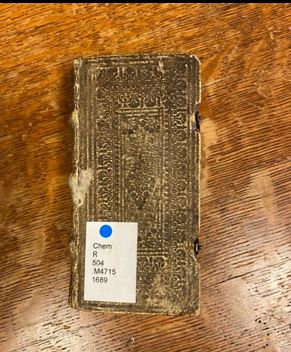The Oesper Collections and Museum in the History of Chemistry at the University of Cincinnati is pleased to present a new blog series, Oesper Collection Highlights. We will feature items from our amazing collections of rare books, prints and portraits, and online collections that inspire and educate all. We thank our student intern, Brenna Kobes, for researching and preparing these posts. If you have questions about the Oesper Collections and Museum, please contact Ted Baldwin, Ted.Baldwin@uc.edu, Director of the UC Science and Engineering Libraries.
Oesper Collection Highlights for March 2022 recognize Women’s History Month and the contributions of women to chemistry over the centuries. We aim to raise awareness and celebration for their accomplishments.
Marie Meurdrac, 17th c. chemist and alchemist
Never judge a book by its cover: La Chymie Charitable et Facile, en Faveur des Dames (Useful and Easy Chemistry, for the Benefit of Ladies)

Fig 1: Oesper collections copy of La Chymie
The outside of this book appears unassuming, and nothing on the front cover (figure 1) would suggest what the inside contains. This book is, of course, titled La Chymie Charitable et Facile, en Faveur des Dames, which translates to Useful and Easy Chemistry, for the Benefit of Ladies, authored by Marie Meurdrac. This book is interesting because it was written in the 1600s by a woman. She justifies her entrance into the male-dominated field by claiming that had women been offered the same education as men, they would be on equal footing (Feinstein, 2009). The text has been likened to a recipe book, a category applied to texts that lay out ingredients and their uses in medical treatments. These types of texts were usually slotted into the rigid categories of “kitchen chemistry” or “cookery” instead of true chemistry or alchemy (Feinstein, 2009). This perception lessened the true contributions made by women within these fields.

Fig 2: Title page, French 2nd ed.
Like other books written during this time, La Chymie is divided into six different parts. The first part explains the terms, methods, and tools used in chemistry, an essential foundation since the audience may have been unfamiliar with the words and tools presented. The second part deals with herbs and their different medicinal uses. In the same way, the third section discusses animals and the fourth discusses minerals. The fifth section is about crafting compound medicines. The sixth and final part provides details on increasing and preserving female beauty. Initially written in French (figure 2), La Chymie was later translated into both German and Italian. Our copy of La Chymie in the Oesper rare books collection is a 1689 German edition (figure 1). The Lloyd Library, lloydlibrary.org, located in downtown Cincinnati, holds a 1711 French edition.
Little is known about Marie Meurdrac herself. We know that she came from wealth and married a military commander. Her knowledge of chemistry came from self-learning and trial and error. She studied the experiments and theoretical work of other scientists to build her understanding of the field. Marie Meurdrac has been hailed the “First Lady of Chemistry” by some scholars. Others question the validity of her work and seek to dismiss her as simply a “kitchen chemist,” a title that places her back into the domestic sphere (Feinstein, 2009). They fail to understand that women have always practiced chemistry of some type. The passages in this Meurdrac’s text guide women in ways to heal and care for those around them. In her time, these roles were traditionally given to women through their work as midwives and as ones that tend to the dead and prepare the body for burial (Fissell, 2008). It is difficult to truly place this book into a particular category. Is it alchemy, kitchen chemistry, or true chemistry? It is difficult to decide, particularly in the backdrop of the 17th century. the contributions that Maire Meurdrac and countless other women have made to the field. Which is something that should not be overlooked or dismissed any further.

Fig 3: Lisdt of substances and symbols from La Chymie (French ed.)
Bibliography
Feinstein, S. (2009). La Chymie for Women: Engaging Chemistry’s Bodies. Early Modern Women: An Interdisciplinary Journal, 223-234.
Fissell, M. E. (2008). Introduction: Women, Health, and Healing in Early Modern Europe. Bulletin of the History of Medicine, 1-17.
Strocchia, S. T. (2014). Introduction: Women and healthcare in early modern Europe. Renaissance Studies, 496-514.
Additional Resources
Wikipedia article: Marie Meurdrac
